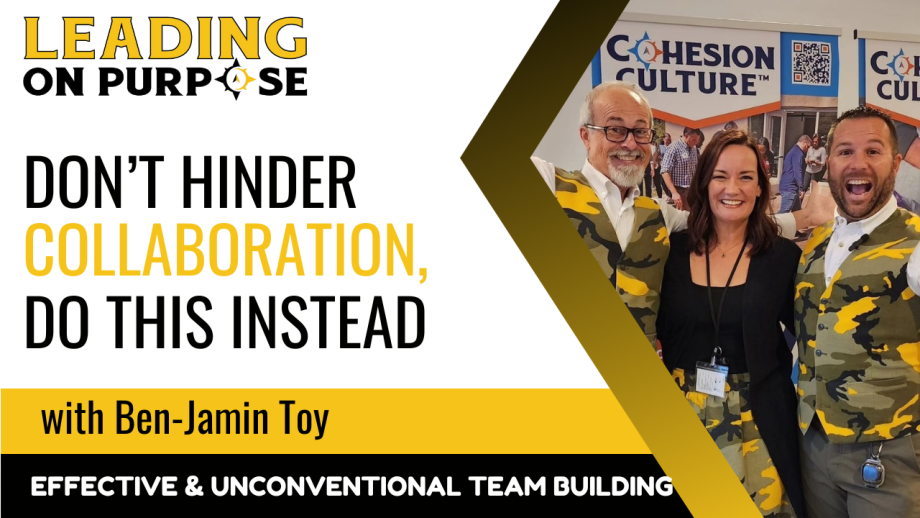
Don't Hinder Collaboration, Do This Instead
"If you want to go fast, go alone. If you want to go far, go together."
It's unclear who coined those words first. Lots of different proverbs say something similar. But to go far and go together requires collaboration.
86% of employees and executives cite lack of collaboration or ineffective communication for workplace failures. (Fierce Inc, 2011)
The Two Cohesive Principles of True Collaboration
When we talk about collaboration, there are two fundamental elements at play:
- Agreement: Everyone on the team must agree they need each other.
- Trust: Teammates believe that every player can be trusted to do their job.
These two principles, agreement that everyone is needed and trust that they will do their job, are required for true collaboration.
At our upcoming Cohesive Leadership Workshop Series on Thursday, November 2nd, we'll dissect these essential components and unpack them in a lot more detail.
Remember if either of these two elements is missing, it is not genuine collaboration.
Consider a scenario where five team members collaborate on a project, with two holding leadership positions. While they claim to collaborate, these leaders lack trust in the other three team members' capabilities to fulfill their tasks. Consequently, they reassign the work of the other team members and provide them with less complex tasks.
This is not true collaboration.
While teamwork is deemed crucial by 75% of employers, 39% of employees report a lack of collaboration. (Troop Messenger)
There is a disconnect between employers belief in teamwork and the employees' actual experience. This disconnect occurs, like in the example above, when leaders don't actually agree that everyone on the team is needed and/or don't trust employees to do their jobs.

Collaboration in Numbers
Collaboration isn't just a corporate buzzword. When people collaborate, innovation, problem-solving, communication, and talent retention thrive.
Collaboration serves as the linchpin for fostering transparency, enhancing productivity, and cultivating employee satisfaction within the workplace. As employees engage in collaborative efforts, exchanging ideas and expertise, they forge connections, become more deeply involved in their roles, and contribute to a dynamic atmosphere characterized by innovation and progress. The evidence demonstrates that this, in turn, positively influences talent retention rates and contributes significantly to the overall success of the organization.
Here are some statistics to back-up this claim:
- 39% of surveyed employees believe that people in their own organization don’t collaborate enough. (Visix.com)
- Teamwork facts show that three-quarters of employers see collaboration as an important factor that significantly impacts the company’s success. Ironically, 39% of employees report a lack of collaboration. (Troop Messenger)
- 75% of virtual teams worldwide say that remote collaboration allowed them to be more effective in their jobs. (Meluso et al., 2020)
- A survey found that 33% of employees believe that cultivating a collaborative culture leads to increased loyalty, (Teamstage.io)
Remote Collaboration
As organizations evolve, remote and hybrid teams become the norm, with virtual teams facing unique challenges.
A study found that 20% of virtual teams find it difficult to collaborate with their colleagues. 10% of virtual workers were also found to struggle in collaborating with their remote teams in different time zones. (Buffer, 2020)
Teams no longer share a single office space. They are now spread across the globe. So, how do remote or hybrid team collaborate effectively?
It starts with leadership. Organizations and their leaders have to provide the resources for remote employees working across time zones to collaborate effectively. This can be through the use of online tools, and further training for employees on these tools and all the features they provide. It can be through team bonding and culture building online activities that encourage collaboration and communication.
Effective collaboration and communication practices are essential for ensuring the success of remote work. The State of Remote Work survey from Buffer discovered that remote workers predominantly rely on messaging apps for collaboration, with 50% favoring this method. This is followed by emails at 22%, and meetings at 19%.
Another key aspect that demonstrates the importance of collaboration for remote employees is that it's a powerful way to combat loneliness and the feeling of isolation. Fully remote employees can go a whole day or even days without speaking a word to another human being.
This can have a negative impact on mental health and decrease employee engagement and happiness at work.
Collaborative teamwork stands as a remedy for combating the sense of isolation. In fact, even informal collaborations, such as virtual co-working, where you co-work in a shared virtual space, or open office hours, where you engage with managers without a specific agenda, can alleviate social isolation.
When collaboration is structured and purposeful, it magnifies these advantages. It cultivates a sense of connection among individuals and instills a feeling of being part of a cohesive team working towards shared objectives. Consequently, this contributes to a more content and engaged workforce, bolstering retention rates.
Transformative Leadership
Directive, Cooperative, Collaborative. What do those things mean? Great question. Those are the styles of leadership best used when you are a transformative leader and you put others first.
Transformative leaders create an environment that values collaboration and teamwork as essential components of success. These leaders empower individuals, place an emphasis on a shared purpose, and encourage open communication, all of which are foundational to effective workplace collaboration. Transformative leaders set the stage for a collaborative workplace culture that is innovative, adaptable, and highly motivated. (For more on leadership, click here to read our article on whether introverts or extroverts make better leaders.)
Learn how Directive, Cooperative, & Collaborative leadership styles are needed and how they differ at the workshop.
Join me on Thursday, November 2nd, for the Cohesive Collaboration Session here in Mount Pleasant, South Carolina. We're going to unpack what true cohesive collaboration means. It's an opportunity to dive deep into the world of true collaborative practices and learn how to create an environment where collaboration thrives.
Experience collaboration through a hands-on, interactive activity that supports the two cohesive principles detailed above. Session includes activity instructions and Culture Cheat Codes for immediate use.
Click here to learn more & register!
If you're interested in reading more, we recommend these blog posts:










